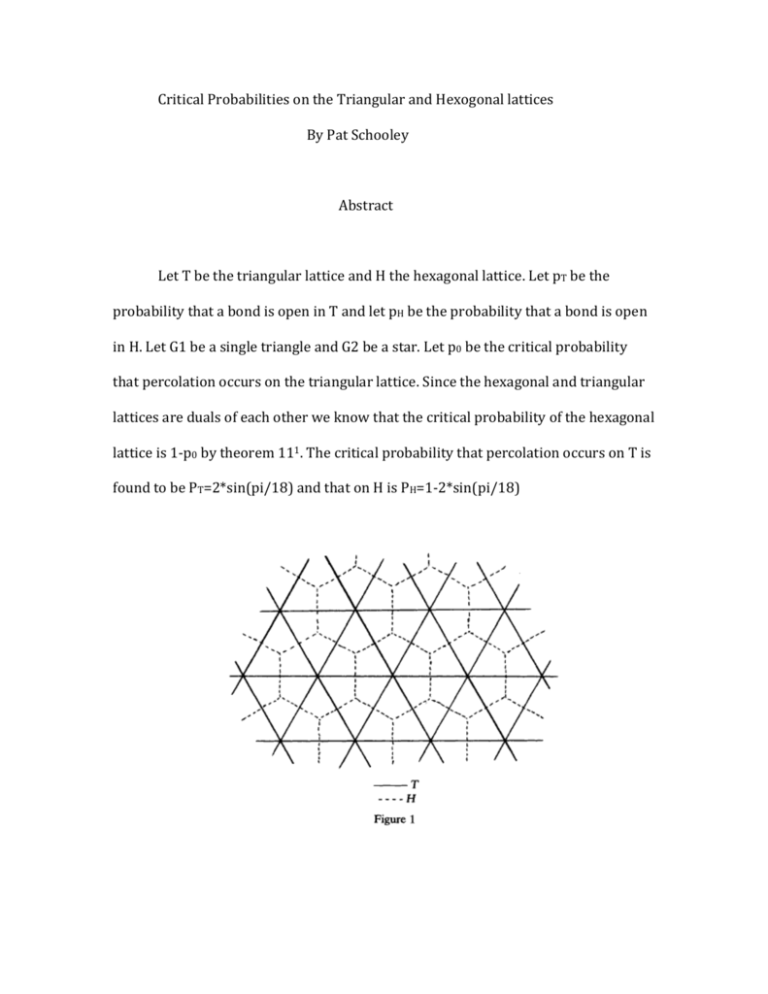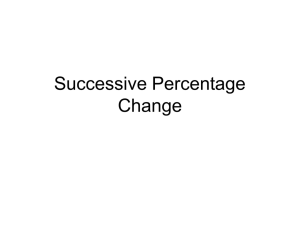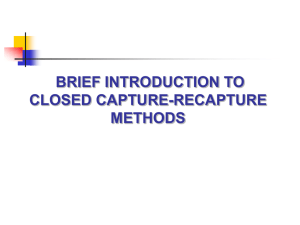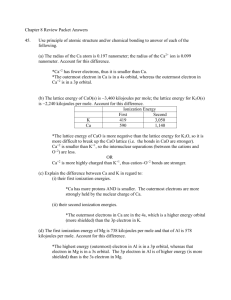Critical Probabilities on the Triangular and Hexagonal Lattices
advertisement

Critical Probabilities on the Triangular and Hexogonal lattices By Pat Schooley Abstract Let T be the triangular lattice and H the hexagonal lattice. Let pT be the probability that a bond is open in T and let pH be the probability that a bond is open in H. Let G1 be a single triangle and G2 be a star. Let p0 be the critical probability that percolation occurs on the triangular lattice. Since the hexagonal and triangular lattices are duals of each other we know that the critical probability of the hexagonal lattice is 1-p0 by theorem 111. The critical probability that percolation occurs on T is found to be PT=2*sin(pi/18) and that on H is PH=1-2*sin(pi/18) Percolation on the triangular and hexagonal lattice was first studied by two professor’s at King’s college in London, names Sykes and Essam. This is covered on pages 148-150 of our textbook and is called the star-delta transformation or the star-triangle transformation. If we have a triangular lattice we want to transform this lattice into a hexagonal lattice to get it’s dual. Bollobas and Riordan started this subject by looking at a single triangle and a single star. The triangle is labeled G1 and we label each vertex x, y, z. Similarly, the star has 4 vertices and the middle one is labeled w. For G1 each bond is open with probability p1, and G2 the bond probability is p2. We’re wanting to transform the triangle into a star, and we start by looking at the probability that the graph is either connected, partially connected, or not connected for the three vertices. The five possibilities are; all are connected, none are connected or one of the three partitions that are isomorphic to; [x, y] is connected and [z] is by itself. G1 G2 All p1^3+3p1^2*(1-p1) p2^3 None (1-p1)^3 (1-p2)^3+3p2*(1-p2)^2 [x, y] p1*(1-p1)^2 p2^2*(1-p2) [y, z] p1*(1-p1)^2 p2^2*(1-p2) [z, x] p1*(1-p1)^2 p2^2*(1-p2) We want to find the probability p0 that makes all five equations equal to each other. Since the bottom three are all the same we will only look at the top three. p1^3+3p1^2*(1-p1) = p2^3 (1-p1)^3 = (1-p2)^3+3p2*(1-p2)^2 p1*(1-p1)^2 = p2^2*(1-p2) The last equation is satisfied when p2= 1-p1, substituting this into the other two equations gives, P1^3 +3p1^2(1-p1) =(1-p1)^3 which yields P1^3-3p1+1=0, for p1 in (0,1) which is the only reasonable interval for p since we are looking at probabilities, we get the solution p1=2sin(pi/18)=.3472. The notation that Bollobas and Riordan, use is Oi, i= 1,2 for any open subgraph of G1 or G2 obtained by selecting each bond with probability p2=1-p1. As all of the above equations are satisfied, the random graphs O1, O2 are equivalent with respect to x, y and z. we can now couple O1 and O2 together so that the exact same pairs of sites are connected in O1 and O2. If we ignore the new site in the middle, this observation allows us to transform any open triangle in our lattice into an open star, since the probabilities of any combination of vertices being connected are equivalent in O1 as in O2 and the number of open clusters is unchanged. Thorem 16 page 149. pcb(T)=2*sin(pi/18) pcb (H)=1-s*sin(pi/18) Proof If we start with a triangular lattice T with bond probability p1, and we substitute a star with bond probability 1-p1, for any of the triangles, we still connect all of the same vertices in T, with the same probability. Since all triangles are independent we can substitute a star with bond probability 1-p1, for every other triangle in T and we get a new lattice H’ in which all the vertices in T are still connected in H’, and for any two connected vertices in T we still have a path in H’ that connects the two vertices. So we now have a new lattice H’ which you can see is simply a hexagonal lattice, so it is isomorphic to H. Now if we label one of the vertex’s in T as 0, and C0 the open cluster in T containing 0, and let C0’ be the open cluster in H’ containing 0. Under our transformation we have C0’ V(T) =C0. As C0’ is a connected subgraph of H’ and sites of V(H’)\V(T) are joined only to sites in V(T), which have degree 3, we have |C0’|<=4*|C0’ n V(T)|. Thus |C0|<=|C0’|<=4*|C0| holds in our graphs, now we know P(|C0|>=n)<=P(|C0’|>=n)<=P(|C0|>=n/4 For every n, as n goes to infinity, we see that the probability that P(|C0’|>=n) is trapped between two probabilities which are equal, so theta(H’: 1-p1)=theta(T:p1). And since H’ is isomorphic to H, theta(H: 1-p1)=theta(T:p1). Now in the book they kind of glaze over this next step and so what they say is, “in proving theorem 11, we showed that, for any p, at most theta(H: 1-p1) and theta(T: p1)can be strictly positive, so theta(H:1-p1)=theta(T:p1)=0, which gives pcb (T)>=p1 and pcb (H)>=1p1. Since pcb (T)+ pcb (H)=1 by theorem 11, we must have pcb (T) + pcb (H)>= p1 + 1 – p1 =1 so we get pcb (T) + pcb (H)=1, so pcb (T)=p1 and pcb (H)=1-p1. References [1] B. Bollobas and O. Riordan (2006), Percolation, Cambridge U. Press, Cambridge UK: Pages 137-138, 148-152 [2]Wierman J. C. [1981]. Bond percolation on honeycomb and triangular lattices. Advances in Applied Probability. 13, 298-313 [3]Sykes M. F., Essam J. W. [1963]. Some exact critical percolation probabilities for site and bond problems in two dimensions. Phys. Rev. Lett. 10, 3-4






